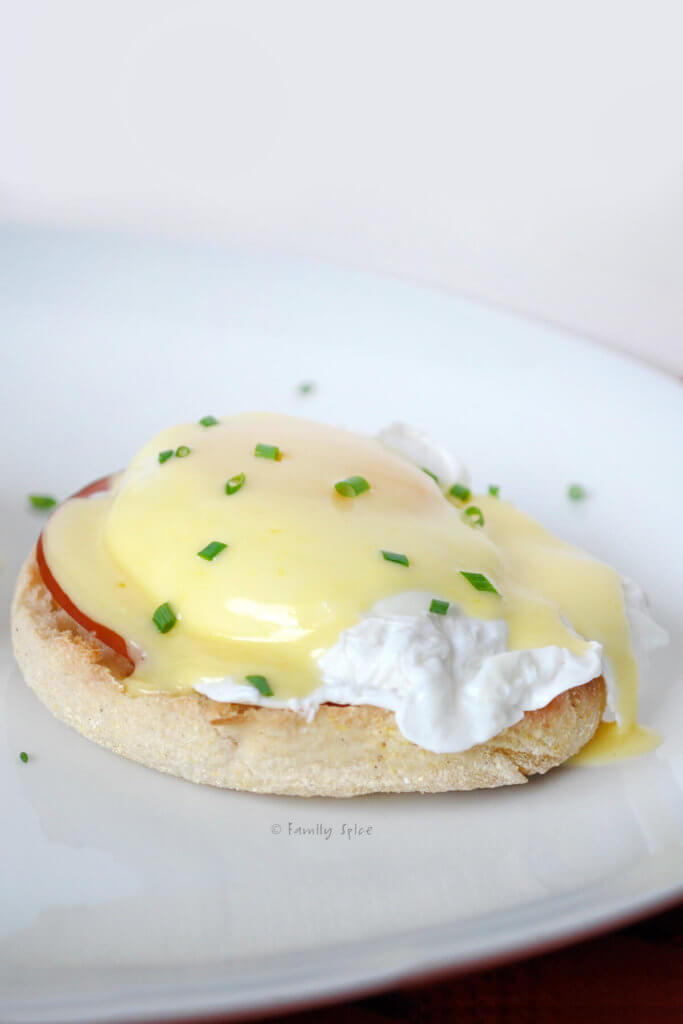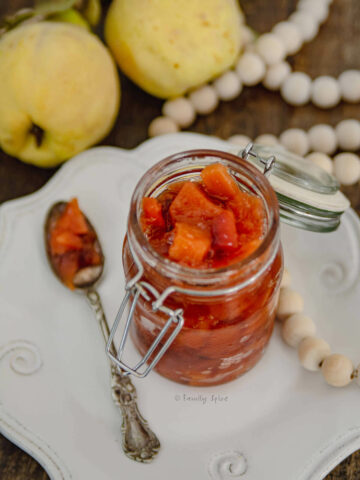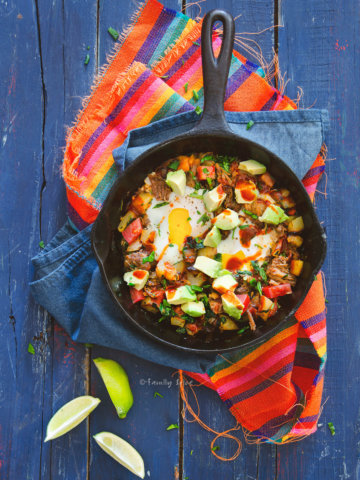For a special occasion breakfast this classic recipe for Alton Brown Eggs Benedict with Hollandaise Sauce is a wonderful treat.

What makes this recipe so awesome
Eggs Benedict is a classic American breakfast – yes, it really does originate from the USA! The real question is who exactly created this dish, although we can narrow it down to originating from New York.
The classic eggs Benedict consists of two halves of an English muffin, toasted and topped with a slice of ham or bacon, poached egg and drizzled with hollandaise sauce. Many variations do exist, some including steak and others including crab meat, but the general formula is the same.

What makes this dish so special is the creamy hollandaise sauce. Although it is tricky to make, with a little patience you can easily make it at home. Making hollandaise sauce means whisking egg yolks over in a double boiler with a little sugar and a whole lot of butter.
But much more slowly than how I described! Slow and steady whisking of the egg yolks until it thickens you add a pat of chilled butter, one at time, until it is melted and combined.
Ingredients you need
- Eggs: Eggs are needed for both the poached egg but also for the hollandaise sauce.
- Sugar: This is Alton Brown’s touch to hollandaise sauce, to balance out the lemon and buttery flavor.
- Butter: Hollandaise sauce uses A LOT of butter so choose a high quality butter.
- Lemon juice: You can use fresh or bottled lemon juice.
- Seasonings: kosher salt and cayenne pepper (optional)
- White wine vinegar: Adding vinegar to the poaching water helps the egg whites firm faster and prevents them from spreading out loose and free in the water.
- Canadian bacon: This is the classic meat for eggs Benedict.
- English muffin: This is the bread base for the eggs Benedict. You can use regular, sourdough or whole wheat.
- Chives (optional): Fresh chives are used to garnish the eggs Benedict and add a touch of onion flavor.
Step-by-step directions
1. In a medium sized mixing bowl and add egg yolks with a little water and whisk for 1-2 minutes, until egg yolks lighten. Whisk in sugar.

2. Place bowl over saucepan of simmering water and whisk steadily 3–5 minutes until the yolks thicken to coat the back of a spoon. Remove from heat, but let the water continue to simmer.

3. Whisk cold butter into the egg mixture, 1 piece at a time. Move the bowl to the pan of simmering water again as needed to melt the butter, making sure to whisk constantly.
4. Once all the butter is incorporated, remove from heat and whisk in ½ teaspoon kosher salt, lemon juice and cayenne pepper. Keep the hollandaise sauce warm while you poach your eggs.

5. Make sure you have 2–3 inches of water in your pan and bring back to a simmer. Add salt and vinegar. In a small bowl, crack 1 egg. Gently pour egg into simmering water.

6. Poach the eggs for 3-5 minutes for a viscous but still runny yolk. If your egg is not cooking fast enough, raise temperature slightly. You do NOT want a rolling boil when poaching eggs.

7. Toast English muffin halves to desired doneness. Warm over medium heat a small non-stick frying pan and add Canadian bacon. Top each half of English muffin with a piece of bacon.

8. Remove one egg with a slotted spoon, draining well, and place on top of the bacon.

9. Top the eggs with hollandaise sauce and chives.

Recipe tips and FAQs
Whether you are making eggs Benedict for one or a crowd, it is good to have all of your ingredients and tools ready and on hand. Timing is pretty important when you are making the hollandaise sauce and poaching eggs, so you don’t want to be “scrambling” for missing items!
One trick I always use when I’m poaching eggs is to crack the egg in a small bowl first. Then you gently slide the egg in to the simmering water. These keeps you from plopping the egg into the water and breaking the yolk. It also helps the egg keep its pretty shape.
The key to reheating hollandaise sauce is to heat it slowly. I nuked it for 8 seconds, then stirred it, nuked again for 8 seconds, stirred, etc… until it warmed up. This keeps the eggs in the sauce from curdling. I could have used a double boiler again, but that required more pots to be washed!
Poaching, in general, is considered to be a healthier way to prepare food because you aren’t using any fats or oils, but water to cook. When you do poach you are using hot water that is simmering, not boiling. And when you are poaching an egg, this is vital because you don’t want your egg to fall apart! Adding vinegar to the poaching water helps the egg whites firm faster and prevents them from spreading out loose and free in the water.

If you are enjoying my recipes, please sign up for my newsletter and get my free 28-day meal plan! You can also follow me on Instagram or Facebook.
Alton Brown Eggs Benedict with Hollandaise Sauce

For a special occasion breakfast this classic recipe for Alton Brown Eggs Benedict with Hollandaise Sauce is a wonderful treat.
Ingredients
- 3 large egg yolks
- 1 teaspoon water
- ¼ teaspoon granulated sugar
- 12 TBS unsalted butter, chilled and cut into small pieces
- ¾ teaspoon kosher salt
- 2 teaspoon lemon juice
- ⅛ teaspoon cayenne pepper (optional)
- ⅛ teaspoon white wine vinegar
- 4 large eggs
- 4 slices of Canadian bacon
- 2 English muffins, split in half
- 1 teaspoon chopped chives
Instructions
- Fill a medium saucepan halfway with water and bring to a simmer.
- In a mixing bowl large enough to sit on the saucepan without touching the water, whisk together 3 egg yolks with 1 teaspoon water.
- Whisk for 1–2 minutes, until egg yolks lighten.
- Whisk in sugar.
- Place bowl in saucepan over simmering water and whisk steadily 3–5 minutes until the yolks thicken to coat the back of a spoon.
- Remove from heat, but let the water continue to simmer.
- Whisk butter into the egg mixture, 1 piece at a time.
- Move the bowl to the pan of simmering water again as needed to melt the butter, making sure to whisk constantly.
- Once all the butter is incorporated, remove from heat and whisk in ½ teaspoon kosher salt, lemon juice and cayenne pepper.
- Keep the hollandaise sauce warm while you poach your eggs.
- Make sure you have 2–3 inches of water in your pan and bring back to a simmer.
- Add ¼ teaspoon salt and vinegar.
- In a small bowl, crack 1 egg. Gently pour egg into simmering water.
- Repeat steps 13 one at a time and cook eggs for 3-5 minutes for a viscous but still runny yolk.
- If your egg is not cooking fast enough, raise temperature slightly. You do NOT want a rolling boil when poaching eggs.
- Warm over medium heat a small non-stick frying pan and add Canadian bacon.
- Toast English muffin halves to desired doneness.
- Top each half of English muffin with a piece of bacon.
- Remove one egg with a slotted spoon, draining well, and place on top of the bacon.
- Repeat with remainder eggs and muffins.
- Top the eggs with chives.
Notes
Serving Suggestions: For a healthy touch, quickly pan-fry collard greens or spinach with salt & pepper. Then, layer between the muffin and bacon.
Nutrition Information:
Yield:
4Serving Size:
1 muffin and eggAmount Per Serving: Calories: 533Total Fat: 45gSaturated Fat: 25gTrans Fat: 0gUnsaturated Fat: 17gCholesterol: 472mgSodium: 837mgCarbohydrates: 15gFiber: 1gSugar: 1gProtein: 18g
PS If you try this recipe, why not leave a star rating in the recipe card right below and/or a review in the comment section further down the page? I always appreciate your feedback.
You can also follow me on Pinterest, Facebook or Instagram. Sign up for my eMail list, too!










Your eggs benedic look fantastic! Seriously, they could not be any more perfect!!
mmmm great step by step photos of poaching! ha yes, the hollandaise does negate any "healthy" aspect of poaching the eggs, but it sure is tasty!
This looks delicious! What a nice wife to get up and make the hubby such an awesome breakfast. I hope he was in a good mood for the rest of the day.